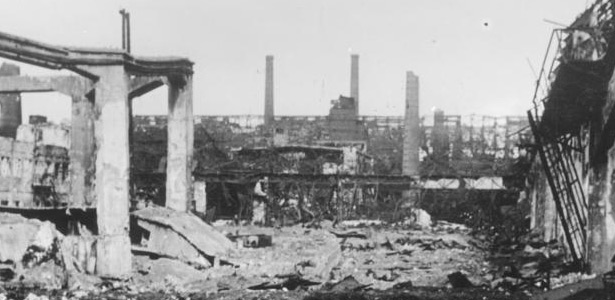While the rules for terrain in Warhammer 40,000 work as an approximation of the effects of terrain on the battlefield, I feel it would be a lot more fun to have terrain play a more active role in a battle, and vice versa. Many video games have taken to having less static terrain, such as entries in the Battlefield series where you can blast apart a building that opposing soldiers are hiding in. Let’s take a look at a few ways you could represent dynamic terrain in 40K.
Remember, these are completely optional rules not endorsed by Games Workshop. You should confer with your opponent before using them in a game, and feel free to modify them as you see fit to suit your needs.
Forest Fires
Using a flamethrower in the woods is always a bit tricky, seeing as there’s all that nice, wonderful wood to set on fire.
Whenever a flamer or variation thereof (i.e. hand flamer, heavy flamer, bale flamer) fires in such a way that more than half of its template passes over a set of woods, roll a D6: On a 4+ the woods catch on fire. Place a suitable marker by the woods to represent this. (You can make a quick and dirty one from attaching some stretched-out cotton to a base, painting it black and dark grey at the top with hues of red and yellow at the bottom, representing smoke rising from flames.)
At the end of each turn, roll a D6: On a 1-3, the flames die out. On a 4+, every unit in the woods take D6 hits at Strength 4 with AP -, applied randomly.
On any given turn, a unit in the woods can spend its Shooting Phase putting out the fire, rather than shooting or running.
Destructible Barricades
Walls are nice protection, but they can’t hold up forever under a withering barrage of fire. A fence, for example, might stop one or two shots from an anti-tank weapon, but it won’t hold out forever.
Assign armor values and hull points to walls and barricades as follows:
Basic wall/obstacle/barricade: Armour 12
Defense wall: Armour 14
Small section: 1 HP
Long section: 2 HP
When a unit using such a wall as cover makes a cover save, resolve the hit against the wall instead. Alternately, a unit may choose to fire at the wall instead of the unit hiding behind it, opting to concentrate their fire in the hopes of taking out their opponents’ cover. Glancing and Penetrating Hits only do 1 HP each.
Blasting the Earth Apart
When a battlecannon shell or an Earthshaker round lands in the ground, it creates a massive blast, throwing the lifeless corpses of their targets flying. In the process, they often cause great gouges to appear in the ground, throwing up dirt and leaving craters in their wake as witnesses to the destruction that just happened.
When a Strength 8 or higher Ordnance weapon attack is resolved (casualties are removed, etc.), place a new crater where the attack landed. This crater should be roughly the size of the large blast marker. (Bonus points if you model unfortunate victims into the crater.) These craters follow the rules for craters from the Warhammer 40,000 rulebook.
For a Strength 8 or higher Apocalyptic Mega-Blast (or similarly sized blast), feel free to use a larger crater, or a series of smaller craters.
“Get rid of that wreck!”
Sometimes a vehicle isn’t entirely destroyed and leaves behind a wrecked hulk, blocking line of fire or causing other problems for units on the battlefield. A determined commander might seek to remove this obstacle.
A wrecked vehicle on the battlefield can be fired at or assaulted as if it was an Immobilized vehicle. Resolve attacks against the vehicle as if it was Open-Topped and subtract 1 from the armor value of each facing (for example, a Rhino would be 10/10/9). While it’s easier to potentially hit something explosive and take out the whole mess, it might still take a lot of firepower or a number of explosive charges to take out the wreck.
If the vehicle suffers an “Explodes!” result, remove it from play and replace it with a crater. Otherwise, it remains in place presenting an obstacle on the battlefield.
Ruined Buildings
Ruined buildings provide great cover for soldiers taking up positions inside them (as well as good vantage points)… but they’re still buildings, subject to all of the things in a battle that might happen to buildings.
In addition to ruined buildings following the typical rules for Ruins (4+ cover save, difficult terrain), they also act as Buildings with Armour 12 and 4 HP. Use the Building Damage Table to determine what happens to ruins that are hit by enemy fire. Results on the chart that refer to an occupying unit will affect one randomly determined unit in the ruined building. If a unit taking cover in a ruined building makes its cover save, resolve the attack against the building instead. While small arms fire ricocheting off the building is no cause for alarm, it’s quite another thing if the building is taking a few too many krak missile hits!

